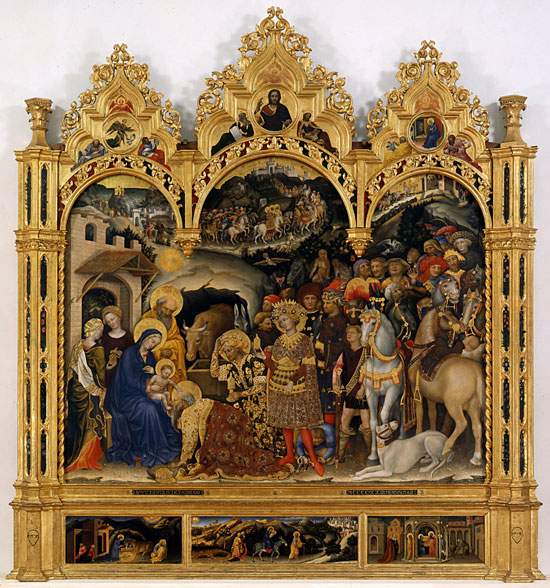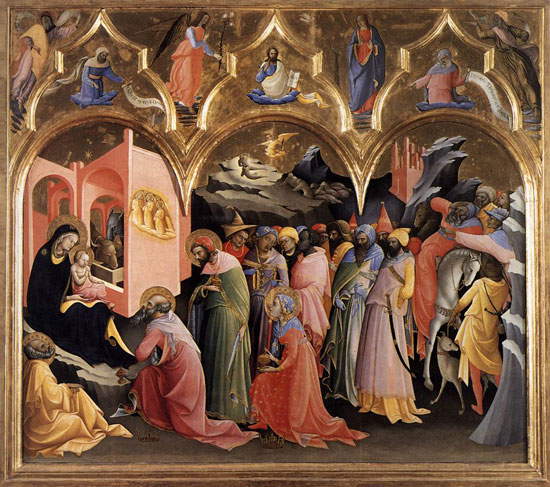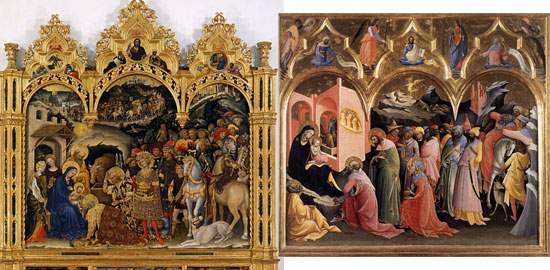So near and yet so far: the Adorations of the Magi by Gentile da Fabriano and Lorenzo Monaco
If your name is Gentile da Fabriano, you have the wealthiest citizen of Florence as a client, and to execute your work you therefore have all the resources you need at your disposal, all you need to do is to put your innate talent and taste for decorative finesse into it, and you will be able to create a painting with a fairy-tale and courtly atmosphere such as the famous Adoration of the Magi now preserved in the Uffizi. But if, on the other hand, your name is Lorenzo Monaco and your ideal of life is an almost ascetic one, eschewing worldliness and luxury, recreating the same atmosphere will be much more difficult for you, though not impossible.
 |
| Gentile da Fabriano, Adoration of the Magi; 1423; Florence, Uffizi |
The International Gothic room in the Uffizi has always been one of my favorites, precisely because it allows a unique comparison between the great masterpieces of the two greatest exponents of the period in Italy: precisely, Gentile da Fabriano and Lorenzo Monaco. Their two Adorations of the Magi are on adjoining walls. One need only stand at a certain point in the room to see them together.
Most, as they walk through the room, linger especially in front of Gentile da Fabriano’s work. All those golds, those precious gems, those richly decorated mantles, that sumptuous procession that has come to adore the Child...in short, all of this exerts a remarkable fascination on visitors to the museum. Who often forget about the painting on the wall next door. Well, I make no secret of the fact that I have more sympathy for Lorenzo Monaco’s work. His task was more difficult. Its appeal is more intellectual and metaphysical than material, like that of Gentile’s work. And the history of Lorenzo’sAdoration, much less documented than that of Gentile’s painting, makes it more interesting in that we do not really know who commissioned the work.
 |
| Lorenzo Monaco, Adoration of the Magi; c. 1422; Florence, Uffizi. |
In 1989, scholar Marvin Eisenberg published a monograph on Lorenzo in which he gave an account of having found documents attesting to the payment of 182 florins for an altarpiece to be given to the church of Sant’Egidio in Florence. A figure, however, deemed too considerable by other scholars for a painting such as the one we can admire today in the Uffizi. And so there still remains doubt as to who was the recipient of the work and who requested it. By contrast, there is no doubt about Gentile’s work, commissioned in 1423 for the church of Santa Trinita by the banker Palla Strozzi, who in 1427 was reported to be the richest man in Florence.
Lorenzo Monaco’s figures, elongated beyond natural proportions, move under broad draperies. The borders with Arabic script lend an exotic charm to the painting. And the borders themselves describe meandering, sinuous lines of unique elegance. Lorenzo Monaco’s is a festive procession, but it appears to us more composed than Gentile da Fabriano’s. Perhaps even more refined, in our eyes: ostentation, after all, is seen today as anything but elegant. And Gentile da Fabriano ’s altarpiece is a hymn to the wealth of the patron, who wanted to stand out, to give a tangible and visual demonstration of his own situation of economic prosperity. Paintings, in the past, also served this purpose.
Gentile’s fairy tale is worldly, earthly: a fairy tale celebrating the comforts of wealth. Lorenzo Monaco, on the other hand, performs a type of operation that is diametrically opposed to that performed by Gentile. In the work of the painter friar, what gives the fairy-tale tones are the poses, the movements, the fluttering of the robes, the features on the faces of the characters, the somewhat questioning expressions of certain protagonists: like the one with the curved sword, who seems to ask the man next to him what the reason for so much homage is. The young man of the Magi, we see him kneeling immediately behind the old man, has such delicate features that he looks like a woman. Even his hands are tapered like a woman’s. Gentile’s, on the other hand, is a prince dressed in a most sumptuous, precious garment. The same is true, in Gentile, of the old man, kneeling at the feet of the Madonna who shows him the Child. The same is true in Lorenzo Monaco, but the mantle of the old man of the Magi is unadorned, sober. It is his gesture, more refined and severe, that makes him appear as elegant as Gentile’s. And what about Lorenzo’s Madonna, with that splendid mantle as blue as night, and like the night decorated only with stars?
 |
| The Adoration of the Magi by Gentile da Fabriano and Lorenzo Monaco compared. |
But if there is one thing I have always admired about Lorenzo Monaco’sAdoration, it is the landscape. In Gentile we have a real space, in which we see the arrival of the procession of the Magi. We can actually follow it from the landing (in fact, we see the sea in the distance) to the arrival at the hut. In Lorenzo Monaco this sense of narrative is missing, but something else happens. The landscape becomes surreal. There are rocks from the totally smooth surface. There are the shepherds, summoned by the angel, who take on the same color tones as the rocks on which they stand, to suggest to the viewer that the scene takes place at night (the perception of colors, at night, is indeed different). There is the angel himself, magnificent in his robe of light. And then there is that bizarre city that appears between the mountains. An abstract geometric shape, rather than a city: the towers are parallelepipeds that cluster within the circle of walls, square, and sometimes blend in with the walls themselves. A city that almost seems to come out of a twentieth-century surrealist or metaphysical painting. And that appears as if it were an enchanted castle: here is the most fairy-tale element of Lorenzo Monaco’s work. And the same forms are recalled in the very strange Jesus Hut: the pink of the perfectly smooth walls is the same as in the enchanted city, the shape of the building is incredibly whimsical and serves more evocative than narrative functions.
“Sinuous Gothic lines that launch themselves right into abstraction,” Vincenzo Costantini wrote in the 1940s about Lorenzo Monaco’sAdoration of the Magi. It is precisely in this abstraction, due to the spiritualism of the painter, that we find the sense of the fantastic in Lorenzo Monaco. Consider the fact that Gentile painted his work just a year after Lorenzo’s, if we take for granted the dating, around 1422, proposed for Lorenzo’sAdoration: the two artists were therefore very close. Two painters who, therefore, shared the historical period, the artistic and cultural temperament, the same city, probably even the same places where they went for their daily activities. Buying colors, looking for helpers, eating something. But their interpretation of the courtly and fairy-tale taste of the International Gothic could not have been so distant. The metaphysical and the mundane. The divine and the earthly. Richly and sumptuously attired figures and sinuous and elusive figures. And even today, six centuries later, on two joined walls, Gentile da Fabriano and Lorenzo Monaco continue to present themselves this way to the eyes of the viewer of their works: two artists so close, yet so far apart.
Warning: the translation into English of the original Italian article was created using automatic tools. We undertake to review all articles, but we do not guarantee the total absence of inaccuracies in the translation due to the program. You can find the original by clicking on the ITA button. If you find any mistake,please contact us.





























